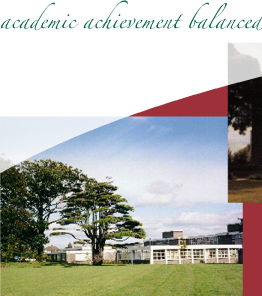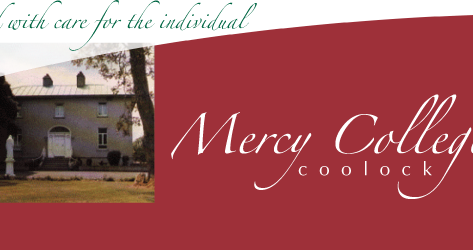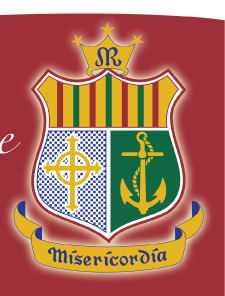 |
 |
 |
| St. Brendan's Drive, Malahide Rd., Dublin 5 | Tel: +353 (0)1 848 0888 / 848 0290 Fax: +353 (0)1 848 0163 | email: info@mercycoolock.ie / web@mercycoolock.ie |
|
Catherine McAuleyEarly LifeTwo hundred years ago Catherine, the future foundress of the Sisters of Mercy, was born in an old Georgian mansion called Stormanstown House. Today the Ballymun flats, a Dublin eyesore, stand where that fine building once stood. No records have survived to show the year of her birth, though, it is believed the date was 29th September 1778. When the Four Courts was burned during the Civil War 1922 valuable deeds and documents were destroyed.Catherine the Dublin child
|
 |
Catherine's Inheritance
Mrs. Callaghan died in 1819 and died a Protestant but she wished to be a Catholic. Mr. Callaghan became a Catholic on the day before he died, but is now buried in the Protestant cemetery in Coolock, next to his wife. In 1821 Mr. Callaghan re-wrote his will and named Catherine as heiress. This document is in the Mercy Convent archives in Baggot Street.
As soon as the affairs were in order Catherine, with the help of Fr. Blake and Fr. Armstrong, bought a site at the corner of Baggot Street and Herbert Street, and with advice from her two Priest friends she found an architect and a builder who started building the large house which within a few years became the first Convent of Mercy.
 |
Inheritance
When William Callaghan died in 1822, Catherine found herself heiress to almost all he possessed. She was mistress of an estate worth more that £25, 000. Today she would be a millionaire.
Catherine's new home, Coolock House, was situated on 22 acres of the finest grazing land and commanded a view of the Dublin Mountains. The estate was bounded partly by the lands of Sir Compton Domville and partly by the lands of the Earl of Howth.
Mercy Sisters
After Catherine O'Callaghan died in 1819 Catherine McAuley, her friend for 20 years, remained on at Coolock House to help the widower William who was now also ill. Some time after his wife's death William asked Catherine what she would do with her life if she were a lady of means. Catherine told him simply and honestly that she would devote her time, energy and wealth to the education and protection of poor women.
At this time in Dublin women were divided into two categories. There were the wives and daughters in the big houses who were educated to be ladies of leisure. They amused themselves by singing, playing the piano, arranging flowers, embroidering, following the hunt and entertaining their friends to afternoon tea. On the other hand there were the poor girls with no education who, if they were lucky, were employed as maids in the big houses. the poor girls were untrained, they received very small wages and if they were annoyed by the gentlemen of the house there was no one to whom they could turn and no place to go. If they were unfortunate enough to become pregnant they were dismissed immediately.
Catherine was very aware of the troubles the poor women were faced with and felt she had to do something about it. This was Georgian Dublin with its beautiful buildings and gracious life-style and where the poor and uneducated had no rights at all.
William O'Callaghan was apparently pleased with Catherine's ideas and on 27th January 1822 made his will leaving his entire fortune and his estate to Catherine. Ten months later William O' Callaghan died and Catherine McAuley at the age of 40 was a wealthy woman. Early in 1823 Catherine consulted a Father Blake from the parish of St. Michael and John and asked him to find a suitable site where she could build a large house which would be used both as an educational establishment and as a refuge for girls needing accommodation. The site which her friend Father Blake recommended was at the corner of Baggot Street and Herbert Street. the site was purchased and the building of what was to become the first Convent of Mercy started in July of 1824.
During the three years that the building was being constructed Catherine studied teaching methods and the management of schools in Ireland and in France. At the same time she and some of her part-time helpers visited the poor in their homes and helped in whatever way they could.
In September 1827 when Baggot street opened as a poor school and as a residence for working girls there was no question of Baggot street being a convent or of Catherine and her voluntary companions ever forming a religious order. In 1828, with the permission of Archbishop Murray Catherine and her companions began visiting some of the hospitals in Dublin.
More young ladies come to help Catherine with her work and the work being done by the group become known and appreciated . The Archbishop realised that the present set-up could not continue ,if the work was to last, so he urged Catherine to consider forming the group into a religious order. she resisted the suggestion for a while but her only other choice would be to hand the work and building the Presentation of Charity Orders.. Since it was very important to Catherine that the group would be free to visit homes and hospitals she decided the better choice was to train as a sister and found her own order. In the early days they were known as 'the walking nuns' as they became a familiar sight on the streets of Dublin.
Catherine with two companions went to the Presentation sisters in George's Hill Dublin from September 1830 to December 1831, to be trained as sisters. When she returned to Baggot street on 12th December 1831 she and her companions were now the first Sisters of Mercy.
From the beginning young ladies were attracted to the work being done by Catherine and her companions and there was a steady stream of candidates joining the Sisters of Mercy.
The work being done by the sisters in Dublin became known in other parts of Ireland also. As new needs arose the sisters were being called on by bishops and priests to serve the need. For example when the Cholera epidemic broke out in Dublin the sisters were asked to nurse the victims which they generously did. By 1835 requests were coming to Baggot Street asking her to set up convents in other parts of the country and in that year a foundation was made in Tullamore, followed some after by foundations in Charleville, Co. Cork in 1837 and in Limerick 1838.
Catherine McAuley and her companions were social workers before the term was invented. In the early 19th century the work of the sisters was so new and so necessary that it attracted a lot of attention.
In 1839 group went from Cork to found a convent in Bermondsey, London. Sr. Clare Moore was in charge of the small group that travelled to Bermondsey and during the 35 years that she lived and worked in Bermondsey she founded 8 other convents in England. Between 1854 and 1856 Sr. Clare Moore and four companions nursed in the Crimea with Florence Nightingale.
Catherine died just 10 short years after founding the Sisters of Mercy in Baggot street. during those 10 years she travelled the length and breadth of Ireland making foundations. Travel was very difficult in those days. She travelled mostly by Canal Barge of by Stage Coach.. The journeys were slow and very tiring and it is not surprising that in 10 years of hardship she was worn out. Because of the difficulty of travel Catherine made each of her foundations autonomous and this explains why Convents of Mercy not only throughout the world but throughout Ireland were totally independent one from the other and this situation only came to an end in 1993? when there was a refounding of the Order with the establishment of Mercy Ireland and Mercy International. Baggot Street the first ever Convent of Mercy is now the headquarters of Mercy International and in funded , managed and maintained by the Sisters from America, Australia, New Zealand and Ireland. The spread of Mercy did not cease when Catherine died in 1841.
Catherine is reported to have said ' it started with two, Sister Doyle and within 100 years the number was 22.000 world-wide. In 1842 a group of sisters went from Dublin to make a foundation in Newfoundland. In 1843 a foundation was made in Pittsburg USA from Carlow. Today in addition to the countries already mentioned there are sisters in South America, West Indies, Philippines, Africa and here in Ireland there is a Mercy convent in practically every town in the country.
Catherine McAuley's project made possible by the kind and wealthy Quaker William O'Callaghan has flourished . the sisters while they do not serve the poor to the exclusion of all others are always identified with the poorer and more deprived in society and this is what Catherine would have wished. The schools and hospitals are second to none they have the highest standards in all areas.
From the beginning the intention was to serve the need of the day. The needs that existed in 1831 when Catherine opened schools for poor girls do not exist in the same way today as the state now provides schools for all and the social welfare Department caters for the homeless. But there are new needs today at the end of the 20th Century and in the true spirit of Catherine the sisters of Mercy now help Aids Victims, alcoholics, Prostitutes and others that are not being adequately looked after by the social services.
In 1839 a group went from Cork to found a convent in Bermondsey, London. Sr. Clare Moore was in charge of the small group that travelled to Bermondsey. During the 35 years she lived and worked in Bermondsey she opened eight other convents in England. Between 1854 and 1856 Sr. Clare Moore and four of her companions nursed the soldiers in the Crimea with Florence Nightingale.
Catherine died just 10 short years after starting the Sisters of Mercy in Baggot Street. During those 10 years she travelled the length and breadth of Ireland opening convents . Travel was very difficult in those days. she travelled mostly by Canal Barge or by Stage Coach. the journeys were slow and very tiring and it is not surprising that she was worn out in a short time. Because of the difficulty of travel Catherine made each of her convents independent and this explains why, convents , not only throughout the world but even in Ireland were separate one from the other and this situation only came to an end in 1993. When there was a refounding of the order with the establishment of Mercy Ireland and Mercy International. Baggot Street, the very first convent is now the headquarters of Mercy International and in funded, managed and maintained by the sisters from America, New Zealand, Australia and Ireland.
| website design by |